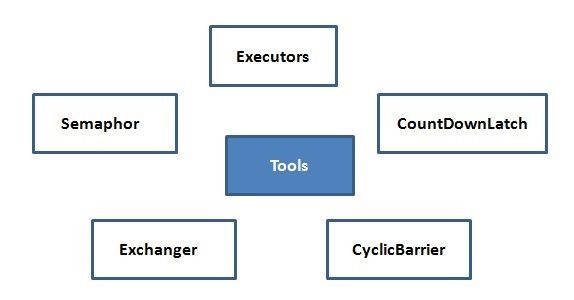java之JUC系列-外部Tools-Executors|Semaphor|Exchanger|CyclicBarrier|CountDownLatch
前面写了两篇JDBC源码的文章,自己都觉得有点枯燥,先插一段JUC系列的文章来换换胃口,前面有文章大概介绍过J U C包含的东西,JUC体系包含的内容也是非常的多,不是一两句可以说清楚的,我这首先列出将会列举的JUC相关的内容,然后介绍本文的版本:Tools部分
J.U.C体系的主要大板块包含内容,如下图所示:
注意这个里面每个部分都包含很多的类和处理器,而且是相互包含,相互引用的,相互实现的。
说到J UC其实就是说java的多线程等和锁,前面说过一些状态转换,中断等,我们今天来用它的tools来实现一些有些小意思的东西,讲到其他内容的时候,再来想想这写tools是怎么实现的。
tools是本文说要讲到的重点,而tools主要包含哪些东西呢:
Tools也包含了5个部分的知识:Executors、Semaphor、Exchanger、CyclicBarrier、CountDownLatch,其实也就是五个工具类,这5个工具类有神马用途呢,就是我们接下来要将的内容了。
Executors:
其实它主要用来创建线程池,代理了线程池的创建,使得你的创建入口参数变得简单,通过方法名便知道了你要创建的线程池是什么样一个线程池,功能大概是什么样的,其实线程池内部都是统一的方法来实现,通过构造方法重载,使得实现不同的功能,但是往往这种方式很多时候不知道具体入口参数的改变有什么意思,除非读了源码才知道,此时builder模式的方式来完成,builder什么样的东西它告诉你就可以。
常见的方法有(都是静态方法):
1、创建一个指定大小的线程池,如果超过大小,放入blocken队列中,默认是LinkedBlockingQueue,默认的ThreadFactory为:Executors.defaultThreadFactory(),是一个Executors的一个内部类。
Executors.newFixedThreadPool(int)
内部实现是:
public static ExecutorService newFixedThreadPool(int nThreads) {
return new ThreadPoolExecutor(nThreads, nThreads,
0L, TimeUnit.MILLISECONDS,
new LinkedBlockingQueue<Runnable>());
}
Executors.newFixedThreadPool(int,ThreadFactory)
内部实现是:
public static ExecutorService newFixedThreadPool(int nThreads, ThreadFactory threadFactory) {
return new ThreadPoolExecutor(nThreads, nThreads,
0L, TimeUnit.MILLISECONDS,
new LinkedBlockingQueue<Runnable>(),
threadFactory);
}
3、创建线程池长度为1的,也就是只有一个长度的线程池,多余的必须等待,它和调用 Executors.newFixedThreadPool(1)得到的结果一样:
Executors.newSingleThreadExecutor()
内部实现是:
public static ExecutorService newSingleThreadExecutor() {
return new FinalizableDelegatedExecutorService
(new ThreadPoolExecutor(1, 1,
0L, TimeUnit.MILLISECONDS,
new LinkedBlockingQueue<Runnable>()));
}是不是蛮简单的,就是在变参数,你自己也可以new的。
4、和方法3类似,可以自定义ThreadFactory,这里就不多说了!
5、创建可以进行缓存的线程池,默认缓存60s,数据会放在一个SynchronousQueue上,而不会进入blocken队列中,也就是只要有线程进来就直接进入调度,这个不推荐使用,因为容易出问题,除非用来模拟一些并发的测试:
Executors.newCachedThreadPool();
内部实现为:
public static ExecutorService newCachedThreadPool() {
return new ThreadPoolExecutor(0, Integer.MAX_VALUE,
60L, TimeUnit.SECONDS,
new SynchronousQueue<Runnable>());
}6、和方法5类似,增加自定义ThreadFactory
7、添加一个Schedule的调度器的线程池,默认只有一个调度:
Executors.newSingleThreadScheduledExecutor();
内部实现为(这里可以看到不是用ThreadPoolExector了,schedule换了一个类,内部实现通过ScheduledThreadPoolExecutor类里面的内部类ScheduledFutureTask来实现的,这个内部类是private,默认是引用不到的哦):
public static ScheduledExecutorService newSingleThreadScheduledExecutor() {
return new DelegatedScheduledExecutorService
(new ScheduledThreadPoolExecutor(1));
}8、和7一样,增加自己定义的ThreadFactory
9、添加一个schedule的线程池调度器,和newFixedThreadPool有点类似:
Executors.newScheduledThreadPool();
内部代码为:
public static ScheduledExecutorService newScheduledThreadPool(int corePoolSize) {
return new ScheduledThreadPoolExecutor(corePoolSize);
}
其实内部Exectors里面还有一些其他的方法,我们就不多说明了,另外通过这里,大家先可以了解一个大概,知道Exectors其实是一个工具类,提供一系列的静态方法,来完成对对应线程池的形象化创建,所以不用觉得很神奇,神奇的是内部是如何实现的,本文我们不阐述文章中各种线程池的实现,只是大概上有个认识,等到我们专门将 Exector系列的时候,我们会详细描述这些细节。
OK,我们继续下一个话题:
Semaphor,这个鸟东西是敢毛吃的呢?
答:通过名字就看出来了,是信号量。
信号量可以干什么呢?
答:根据一些阀值做访问控制。
OK,我们这里模拟一个当多个线程并发一段代码的时候,如何控制其访问速度:
import java.util.Random;
import java.util.concurrent.Semaphore;
public class SemaphoreTest {
private final static Semaphore MAX_SEMA_PHORE = new Semaphore(10);
public static void main(String []args) {
for(int i = 0 ; i < 100 ; i++) {
final int num = i;
final Random radom = new Random();
new Thread() {
public void run() {
boolean acquired = false;
try {
MAX_SEMA_PHORE.acquire();
acquired = true;
System.out.println("我是线程:" + num + " 我获得了使用权!" + DateTimeUtil.getDateTime());
long time = 1000 * Math.max(1, Math.abs(radom.nextInt() % 10));
Thread.sleep(time);
System.out.println("我是线程:" + num + " 我执行完了!" + DateTimeUtil.getDateTime());
}catch(Exception e) {
e.printStackTrace();
}finally {
if(acquired) {
MAX_SEMA_PHORE.release();
}
}
}
}.start();
}
}
}
接下来:
Exchanger十个神马鬼东西呢?
答:线程之间交互数据,且在并发时候使用,两两交换,交换中不会因为线程多而混乱,发送出去没接收到会一直等,由交互器完成交互过程。
啥时候用,没想到案例?
答:的确很少用,而且案例很少,不过的确有这种案例,Exchanger
import java.util.concurrent.Exchanger;
public class ExchangerTest {
public static void main(String []args) {
final Exchanger <Integer>exchanger = new Exchanger<Integer>();
for(int i = 0 ; i < 10 ; i++) {
final Integer num = i;
new Thread() {
public void run() {
System.out.println("我是线程:Thread_" + this.getName() + "我的数据是:" + num);
try {
Integer exchangeNum = exchanger.exchange(num);
Thread.sleep(1000);
System.out.println("我是线程:Thread_" + this.getName() + "我原先的数据为:" + num + " , 交换后的数据为:" + exchangeNum);
} catch (InterruptedException e) {
e.printStackTrace();
}
}
}.start();
}
}
}
这里运行你可以看到,如果某个线程和另一个线程传送了数据,它接受到的数据必然是另一个线程传递给他的,中间步骤由Exchanger去控制,其实你可以说,我自己随机取选择,不过中间的算法逻辑就要复杂一些了。
接下来:
CyclicBarrier,关卡模式,搞啥玩意的呢?
答:当你在很多环节需要卡住,要多个线程同时在这里都达到后,再向下走,很有用途。
能否举个例子,有点抽象?
答:团队出去旅行,大家一起先达到酒店住宿,然后一起达到游乐的地方游玩,然后一起坐车回家,每次需要点名后确认相关人员均达到,然后LZ一声令下,触发,大伙就疯子般的出发了。
下面的例子也是以旅游的方式来呈现给大家:
import java.util.concurrent.BrokenBarrierException;
import java.util.concurrent.CyclicBarrier;
public class BarrierTest {
private static final int THREAD_COUNT = 10;
private final static CyclicBarrier CYCLIC_BARRIER = new CyclicBarrier(THREAD_COUNT ,
new Runnable() {
public void run() {
System.out.println("======>我是导游,本次点名结束,准备走下一个环节!");
}
}
);
public static void main(String []args)
throws InterruptedException, BrokenBarrierException {
for(int i = 0 ; i < 10 ; i++) {
new Thread(String.valueOf(i)) {
public void run() {
try {
System.out.println("我是线程:" + this.getName() + " 我们达到旅游地点!");
CYCLIC_BARRIER.await();
System.out.println("我是线程:" + this.getName() + " 我开始骑车!");
CYCLIC_BARRIER.await();
System.out.println("我是线程:" + this.getName() + " 我们开始爬山!");
CYCLIC_BARRIER.await();
System.out.println("我是线程:" + this.getName() + " 我们回宾馆休息!");
CYCLIC_BARRIER.await();
System.out.println("我是线程:" + this.getName() + " 我们开始乘车回家!");
CYCLIC_BARRIER.await();
System.out.println("我是线程:" + this.getName() + " 我们到家了!");
} catch (InterruptedException e) {
e.printStackTrace();
} catch (BrokenBarrierException e) {
e.printStackTrace();
}
}
}.start();
}
}
}
测试结果中可以发现,大家一起走到某个步骤后,导游说:“我是导游,本次点名结束,准备走下一个环节!”,然后才会进入下一个步骤,OK,这个有点意思吧,其实赛马也是这个道理,只是赛马通常只有一个步骤,所以我们还有一个方式是:
CountDownLatch的方式来完成赛马操作,CountDownLatch是用计数器来做的,所以它不可以被复用,如果要多次使用,就要从新new一个出来才可以。我们下面的代码中,用两组赛马,每组5个参与者来,做一个简单测试:
import java.util.concurrent.CountDownLatch;
public class CountDownLatchTest {
private final static int GROUP_SIZE = 5;
public static void main(String []args) {
processOneGroup("分组1");
processOneGroup("分组2");
}
private static void processOneGroup(final String groupName) {
final CountDownLatch start_count_down = new CountDownLatch(1);
final CountDownLatch end_count_down = new CountDownLatch(GROUP_SIZE);
System.out.println("==========================>\n分组:" + groupName + "比赛开始:");
for(int i = 0 ; i < GROUP_SIZE ; i++) {
new Thread(String.valueOf(i)) {
public void run() {
System.out.println("我是线程组:【" + groupName + "】,第:" + this.getName() + " 号线程,我已经准备就绪!");
try {
start_count_down.await();//等待开始指令发出即:start_count_down.countDown();
} catch (InterruptedException e) {
e.printStackTrace();
}
System.out.println("我是线程组:【" + groupName + "】,第:" + this.getName() + " 号线程,我已执行完成!");
end_count_down.countDown();
}
}.start();
}
try {
Thread.sleep(1000);
} catch (InterruptedException e) {
e.printStackTrace();
}
System.out.println("各就各位,预备!");
start_count_down.countDown();//开始赛跑
try {
end_count_down.await();//等待多个赛跑者逐个结束
} catch (InterruptedException e) {
e.printStackTrace();
}
System.out.println("分组:" + groupName + "比赛结束!");
}
}
public class ThreadJoinTest {
private final static int GROUP_SIZE = 5;
public static void main(String []args) throws InterruptedException {
Thread []threadGroup1 = new Thread[5];
Thread []threadGroup2 = new Thread[5];
for(int i = 0 ; i < GROUP_SIZE ; i++) {
final int num = i;
threadGroup1[i] = new Thread() {
public void run() {
int j = 0;
while(j++ < 10) {
System.out.println("我是1号组线程:" + num + " 这个是我第:" + j + " 次运行!");
}
}
};
threadGroup2[i] = new Thread() {
public void run() {
int j = 0;
while(j++ < 10) {
System.out.println("我是2号组线程:" + num + " 这个是我第:" + j + " 次运行!");
}
}
};
threadGroup1[i].start();
}
for(int i = 0 ; i < GROUP_SIZE ; i++) {
threadGroup1[i].join();
}
System.out.println("-==================>线程组1执行完了,该轮到俺了!");
for(int i = 0 ; i < GROUP_SIZE ; i++) {
threadGroup2[i].start();
}
for(int i = 0 ; i < GROUP_SIZE ; i++) {
threadGroup2[i].join();
}
System.out.println("全部结束啦!哈哈,回家喝稀饭!");
}
}
代码是不是繁杂了不少,呵呵,我们再看看上面的信号量,如果不用工具,自己写会咋写,我们模拟CAS锁,使用Atomic配合完成咋来做呢。也来玩玩,呵呵:
import java.util.concurrent.atomic.AtomicInteger;
public class ThreadWaitNotify {
private final static int THREAD_COUNT = 100;
private final static int QUERY_MAX_LENGTH = 2;
private final static AtomicInteger NOW_CALL_COUNT = new AtomicInteger(0);
public static void main(String []args) throws InterruptedException {
Thread []threads = new Thread[THREAD_COUNT];
for(int i = 0 ; i < THREAD_COUNT ; i++) {
threads[i] = new Thread(String.valueOf(i)) {
synchronized public void run() {
int nowValue = NOW_CALL_COUNT.get();
while(true) {
if(nowValue < QUERY_MAX_LENGTH && NOW_CALL_COUNT.compareAndSet(nowValue, nowValue + 1)) {
break;//获取到了
}
try {
this.wait(1000);
} catch (InterruptedException e) {
e.printStackTrace();
}
nowValue = NOW_CALL_COUNT.get();//获取一个数据,用于对比
}
System.out.println(this.getName() + "======我开始做操作了!");
try {
Thread.sleep(1000);
} catch (InterruptedException e) {
e.printStackTrace();
}
System.out.println(this.getName() + "======操作结束了!");
NOW_CALL_COUNT.getAndDecrement();
this.notify();
}
};
}
for(int i = 0 ; i < THREAD_COUNT ; i++) {
threads[i].start();
}
}
}
还是有点意思哈,这样写就是大部分人对while循环那部分会写晕掉,主要是要不断去判定和尝试,wait()默认是长期等待,但是我们不想让他长期等待,就等1s然后再尝试,其实例子还可以改成wait一个随机的时间范围,这样模拟的效果会更加好一些;另外实际的代码中,如果获取到锁后,notify方法应当放在finally中,才能保证他肯定会执行notify这个方法。
OK,本文就是用,玩,希望玩得有点爽,我们后面会逐步介绍它的实现机制以及一写线程里头很好用,但是大家又不是经常用的东西。

